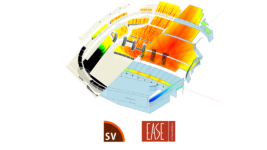LIVE
4 Dec 2023
MUSHROOM 50
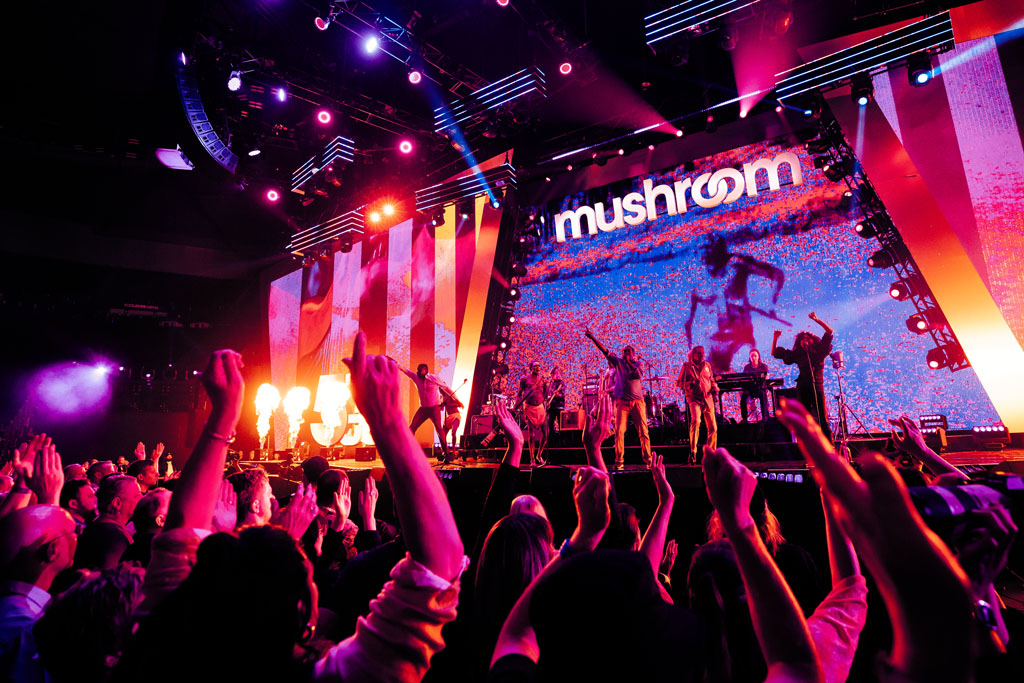
Subscribe to CX E-News
It’s All About Family
It was an audacious plan, executed flawlessly. Choose 50 songs from Mushroom Group’s 50 year catalogue, put the performers on stage, and broadcast the whole thing live on Channel 7. On Sunday 26 November at Rod Laver Arena in Melbourne, Mushroom delivered one of the most technically complicated concerts I’ve ever seen, all while going live to broadcast, and totally nailed every aspect.
A packed roster of beloved music royalty (Paul Kelly, Jimmy Barnes), Australian artists with careers almost as old as Mushroom (Ross Wilson, Red Symons), and exciting up and comers (special mention to the absolute dynamite that was Logan) made for four hours of hits, nostalgia, and surprises. The fact that big international Mushroom acts like Ed Sheeran and Foo Fighters couldn’t make it made the show feel much more like a celebration of Australia and family. Almost every artist, either on stage or beaming in via video, mentioned that Mushroom feels like their family, a sentiment that Mushroom’s dedicated production crew share.
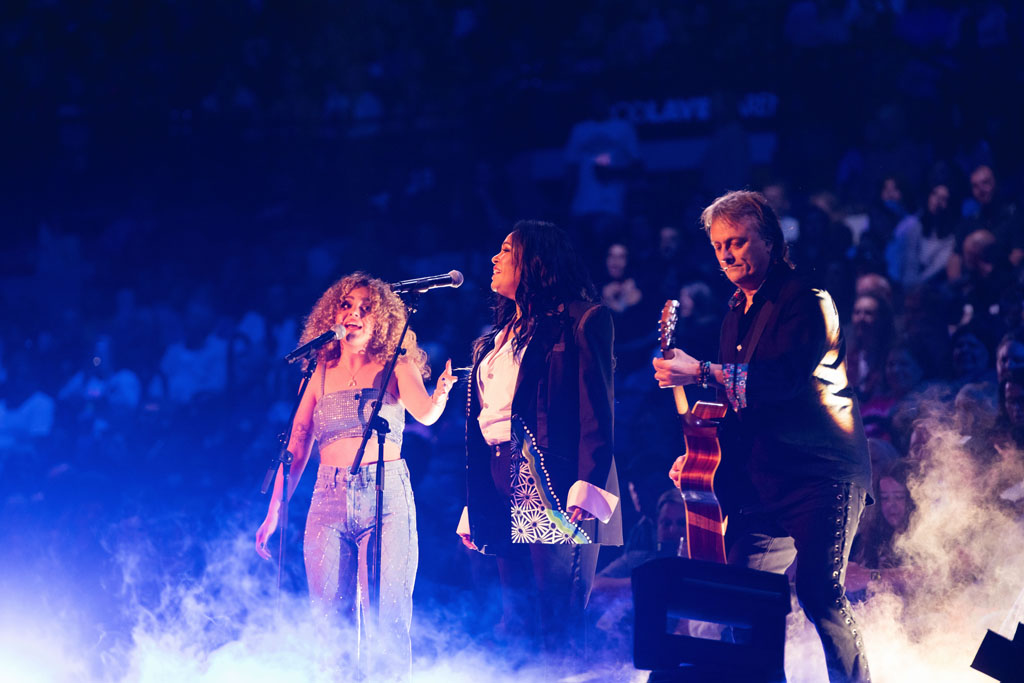
In what has been a bruising year for Indigenous Australians, Mushroom put First Nations performers front and centre. Christine Anu and her daughter Zipporah delivered a stunning version of ‘My Island Home’ that had the crowd cheering the line “I come from the saltwater people”. Mushroom have been championing Indigenous Australian artists for decades, and their audience is with them. The programme then very neatly segued into Goanna performing their hit protest song ‘Solid Rock’.
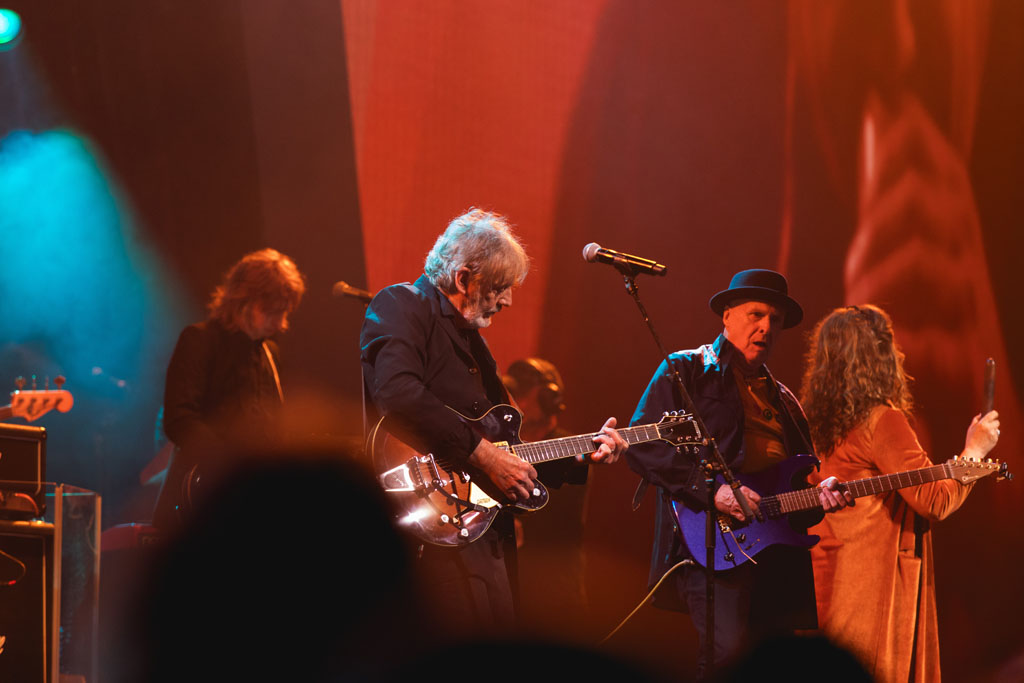
The full might of Arnhem Land’s Yothu Yindi was one of the biggest performances of the night, and the full band and dancers performing ‘Treaty’ brought the house down and effectively closed the first half, complete with pyros.
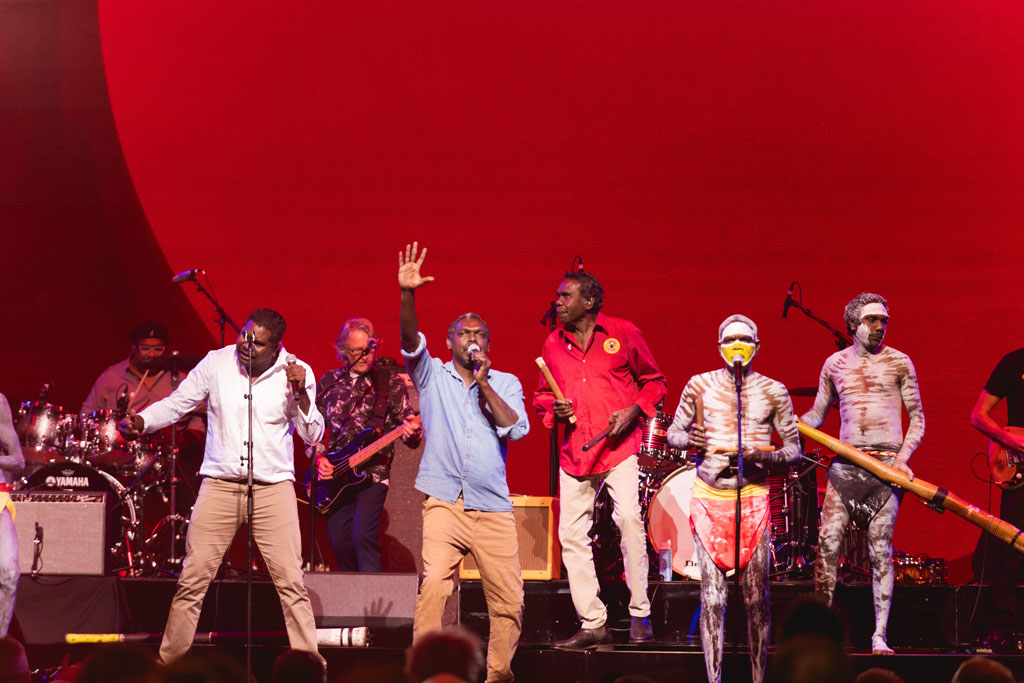
Later in the night, an absolutely gut-wrenching performance from Dan Sultan of Archie Roach’s ‘Took The Children Away’ produced a standing ovation, and he deserved it.
What made the production logistics feasible in Travis Hogan and Simon Johnson’s production design was the revolve centre stage. The plan divided the revolve in half and set what they called the ‘house band’ on one side. The giant centre LED screen would fly out to facilitate the revolve and changeover, then fly in to hide what was going on behind it. The house setup stayed patched and more or less constant through the evening. They would perform two or three songs with guest vocalists, while an army of techs behind the screen set up for the ‘feature act’ that was on next. Taking a little pressure off the main stage was the third ‘acoustic’ stage, set-up just behind the FoH control position, which came in to play just three times during the show.

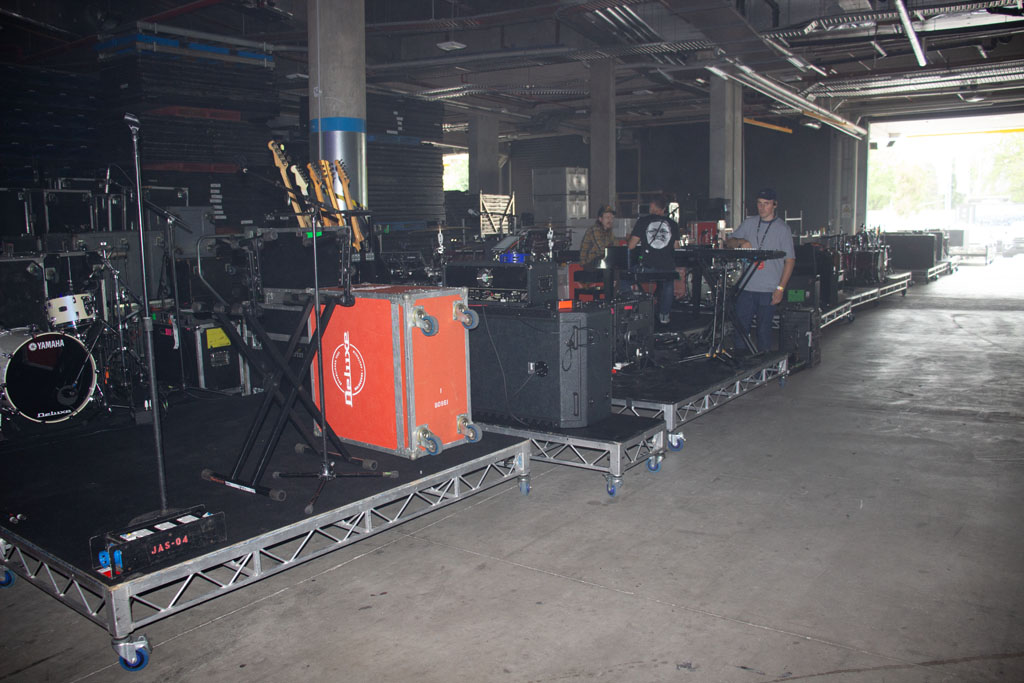
This meant there was effectively 30 concerts worth of equipment in play, with only one of them staying set up and patched. Every changeover involved rolling out a fully set-up riser, setting the revolve with all the band equipment and a full mic kit, and patching it in. I was watching James ‘Oysters’ Kilpatrick at the FoH mix position during the house band sections, mixed by Jimmy Foster on another desk. Oysters was on cans with talkback mic pretty much until the last minute of every changeover, checking all the lines with the techs backstage. He looked calm and composed, but just watching him was giving me anxiety.
“Yeah, there was a fair bit going on backstage,” quips Hayden Vassallo, Stage and Backline Manager on the night. “The feature acts all have dedicated gear on dedicated risers. This is more gear than your average festival. Rod Laver has four laneways backstage. We’ve got one for video, one for control, and two for band risers. We are very limited in how much time we have for changeovers; it’s either two or three songs. And when they come off, we’re clearing the dock and getting ready for the load out during the show.”

All of these channels meant Audio Director James ‘Oysters’ Kilpatrick’s biggest job was organising the patching. “I got to Rod Laver on Monday 20 and spent 12 hours a day in a side office programming and updating the patch and the set list,” relates Oysters. “I’ve been working what’s probably the equivalent of part- time for a month just on the patch.”
The gig was mixed out the front on a DiGiCo SD12 for the feature acts and an SD10 for the house band, with a DiGiCo SD5 and SD10 on monitors, and an SD11 on the acoustic stage. All the DiGiCo SD- and Nano-Rack I/O was linked by a fibre loop. And here’s where it gets complicated. “Each stage has a different I/O system,” outlines Oysters. “On the main stage, there is an A and B SD-Rack for FoH, an A and B SD-Rack for monitors, and A and B SD- Racks for the OB trucks. When A stage is on, B stage is setting up and trucks are checking, and vice versa. There’s also a set of tails for Hunters and Collector’s AVID S6L and another set of tails for Temper Trap’s SD11 monitor desk. That’s eight SD-Racks in total, essentially a four-way split that goes to each stage.”
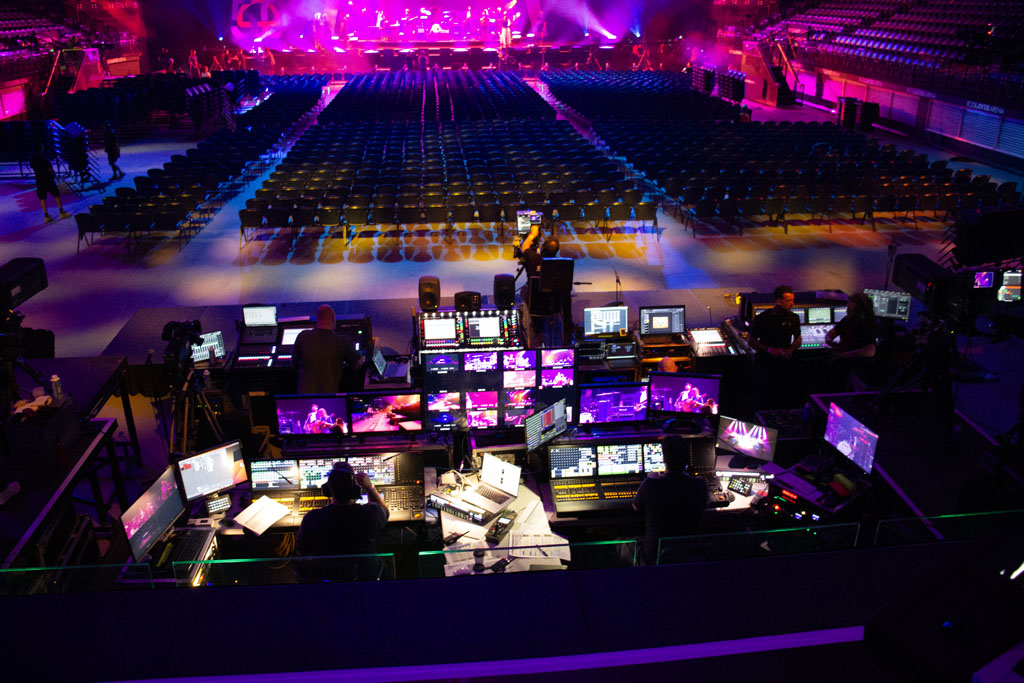

With the patch carefully mapped out, it meant that everything had to go in an exact order. “If someone on the B stage is checking mics and ears, they can’t be appearing in the ears and mics for the next band on the B stage, who are likely to already be wearing their ears,” continues Oysters. “If the order gets changed, then it bumps every single mic out of sequence. So, the patch crew is huge, and they’ve got the thankless task. It’s two or three songs then changeover, and at one point there’s two acts on stage, and a video to segue to a third. Honestly, me mixing this gig out the front is the easiest bit.”
Needless to say, the show sounded absolutely amazing. Oysters’ PA of choice was a mighty d&b audiotechnik KSL rig with 52 elements of KSL8, 12 elements of KSL12, 12 flown SL-SUB subwoofers augmented with eight ground stacked, and eight d&b audiotechnik Y10Ps as in-fill. I find the vocal clarity especially worthy of praise, across all of the various genres of music on the night.
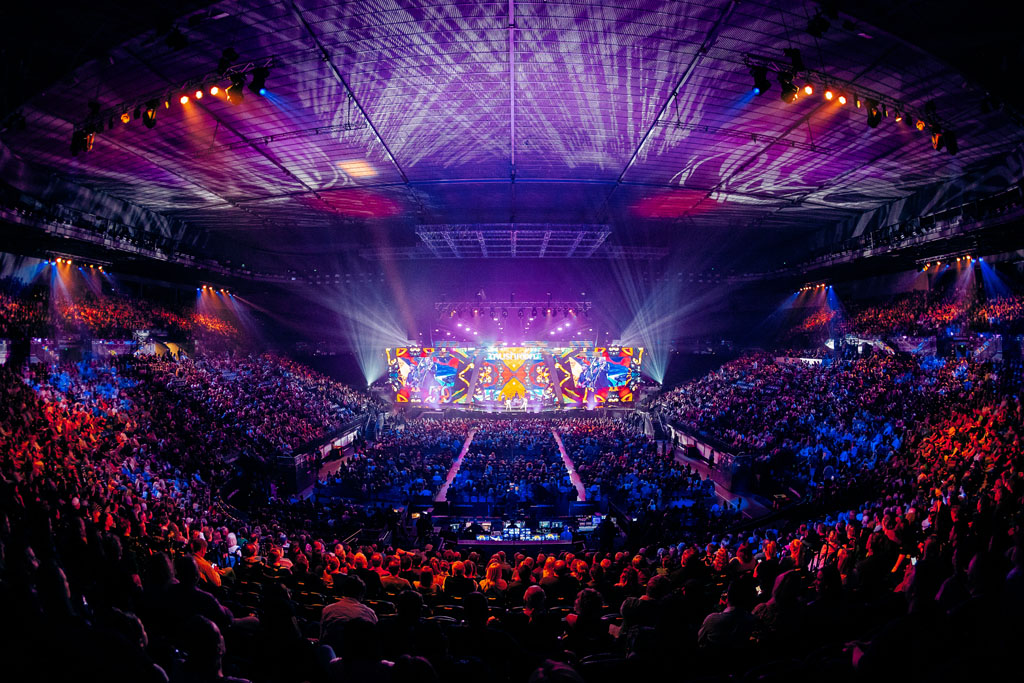
While Oysters was balancing levels, Lighting Director Hugh Taranto was balancing a spectacular amount of LED screen, a rock’n’roll light show, and a TV broadcast. The biggest screen ever built in Rod Laver, comprising 915 panels of ROE MC5 and taking up 204 sqm, was separated into left, centre and right, and filled the venue with about a foot to spare each side.
“It’s all about balance,” posited Hugh. “In the tech rehearsals, we made sure the front light and screen intensity are balanced through each song so the cameras aren’t having to wind irises in and out. The screens can’t overpower the lights and the lights can’t overpower the screens. All the cameras are irised down so the exposure is right for the artist’s faces; if the screen content is too bright, they bleed out and become oversaturated. Ultimately, we’re trying to capture a concert instead of creating a TV show, so I’m still using saturated colour on faces, and it still looks like a rock concert.”
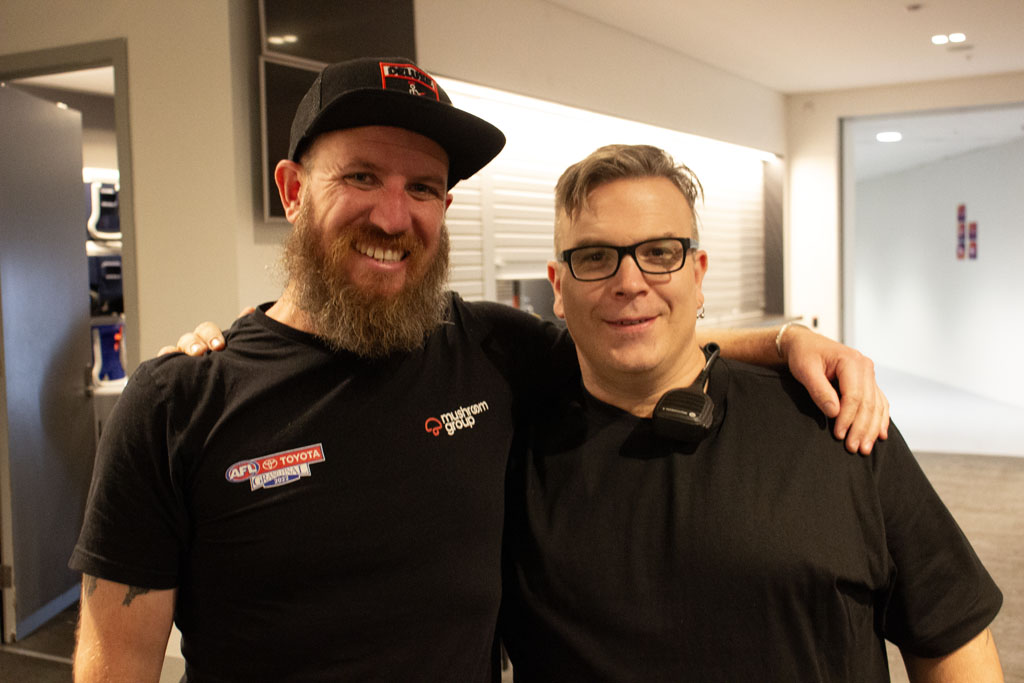
With the rig designed by Travis Hogan and Simon Johnson, Hugh came in to finesse the details and work with broadcast to get it right. “We made a couple of changes for broadcast like bringing the lights down lower into view and moving a couple of things to better places for the cameras,” Hugh continues. “The original plan was to use the house follow spot positions in the gantry, but because broadcast brought in Spidercam, we’ve gone with four PRG GroundControl spots rigged on the FoH truss, which gives Spidercam a defined path to avoid.”
Along with a stable of concert mainstay fixtures from GLP, Martin, Claypaky, and Ayrton, lighting distributors ULA Group and Showtools came to the party with both custom-built elements and new toys. Hanging above the proscenium were eight pod fascias custom built by Showtools, fitted with four strips of LED tape, with 96 controllable LEDs per metre. They contributed to some great old-school looks reminiscent of Countdown, did some animated chases, and could also work with video and pixel map, which was used to great effect in Dan Sultan’s set, with the screen and strips became a giant campfire.
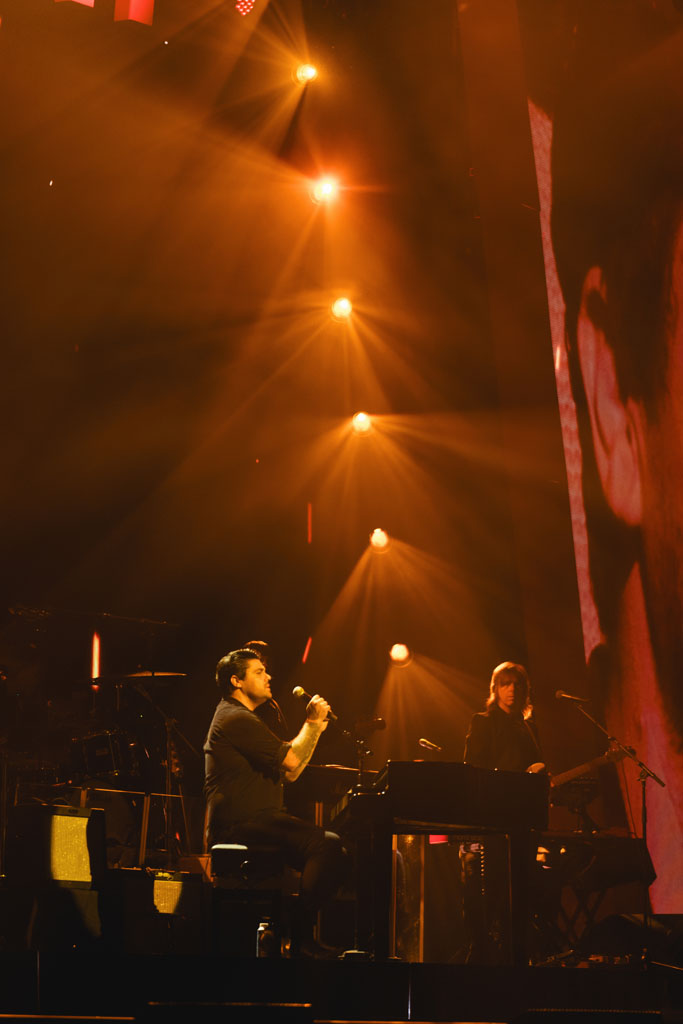
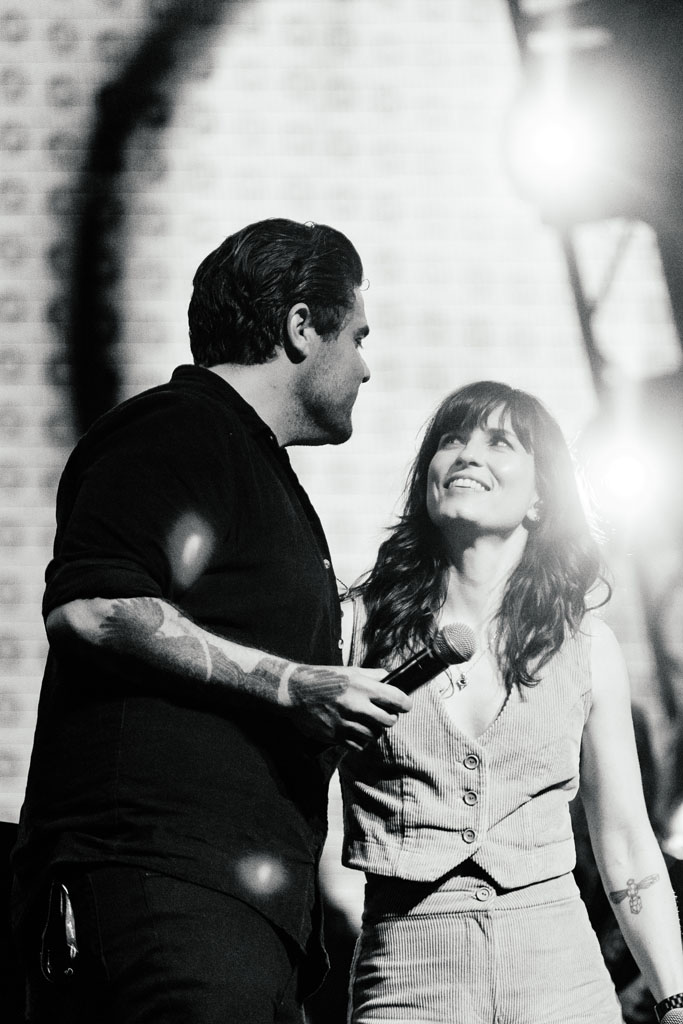
“The pixel tape in the pods is mapped and controlled by a PRG Mbox Studio+ that I brought along with my kit,” says Hugh. “We are running some generic content through them, as well as taking an SDI feed from the disguise media server. We’re using 72 Universes to control 12,288 LED chips.”
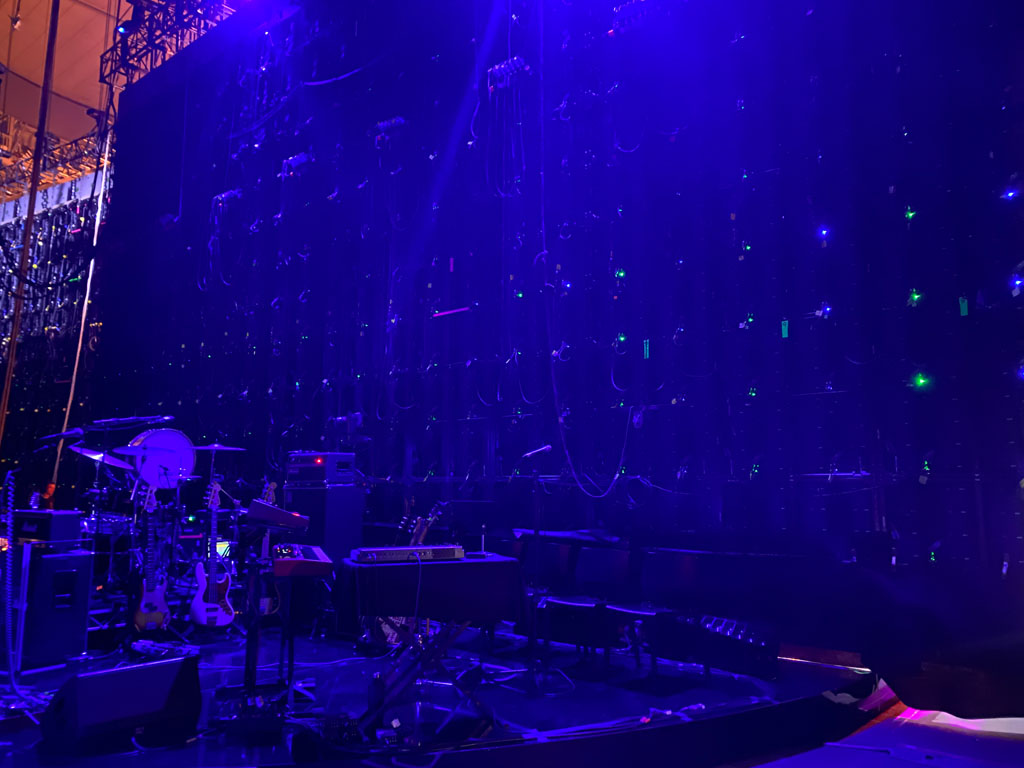
Another Showtools addition was 24 COLORado PXL Curve 12s, a fully pixel mappable motorised RGBW LED batten with individual control of zoom, tilt, and colour across twelve independent heads. “That is a cool fixture!” beamed Hugh. “We had them all round the base of stage, on the house band side of the revolve, and on the acoustic stage. We’re using them as effect lights, footlights, beams, and more.”
ULA Group supplied 16 ACME Geminis, a dual-function bar and strobe fixture. “They’ve got individual cells on a rotating yoke with continuous pan and tilt,” enthuses Hugh. “On one side there’s a 36 LED strobe, and on the other there’s five RGBW, so if you send them tumbling around, they can create some really cool effects. It’s like getting two lights for one.”
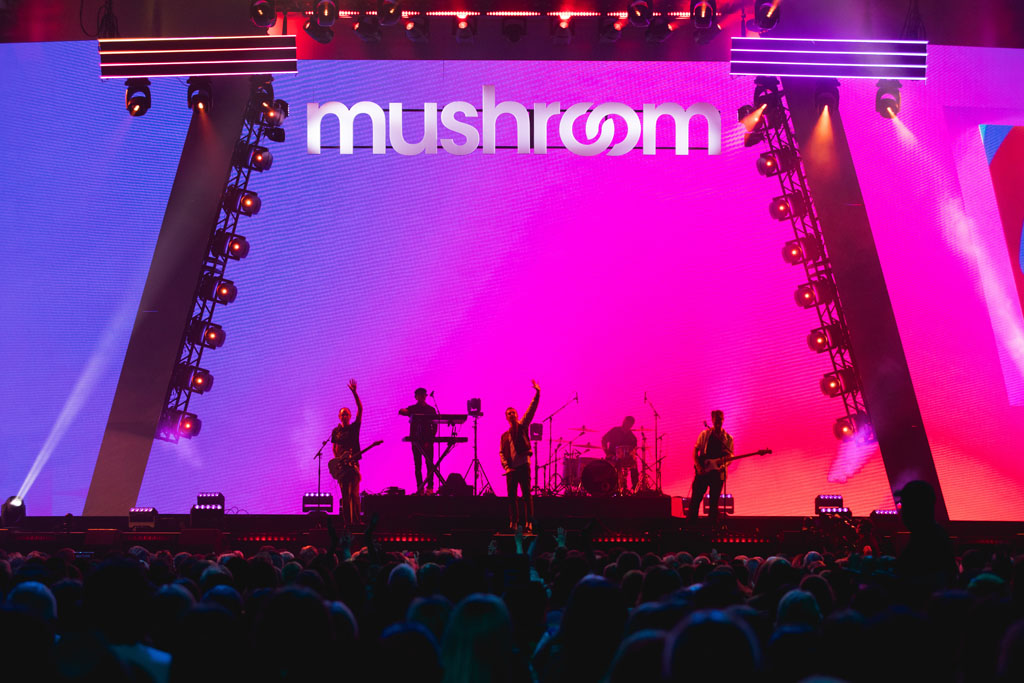
With massive LED screens dominating the design, Mushroom’s in-house creatives made custom content for every song. “We’re up to 3.6TB of content,” says Dan Aulich, Head of Video. “We’re running two disguise vx 4 servers, outputting three 4K outputs, so we’re 12K wide. It’s a lot of pixels! The ROE LED panels are only running at 3%, and they’re still punching through nicely.”
As expected on a live broadcast, there are a lot of cameras in the room. “Between us and broadcast, there are close to 40 cameras on the gig,” Dan continues. “On our side, we’re doing IMAG integrated through disguise, running GrassValley FoH long lenses, and Panasonic PTZs on the band, and taking some feeds from broadcast.”
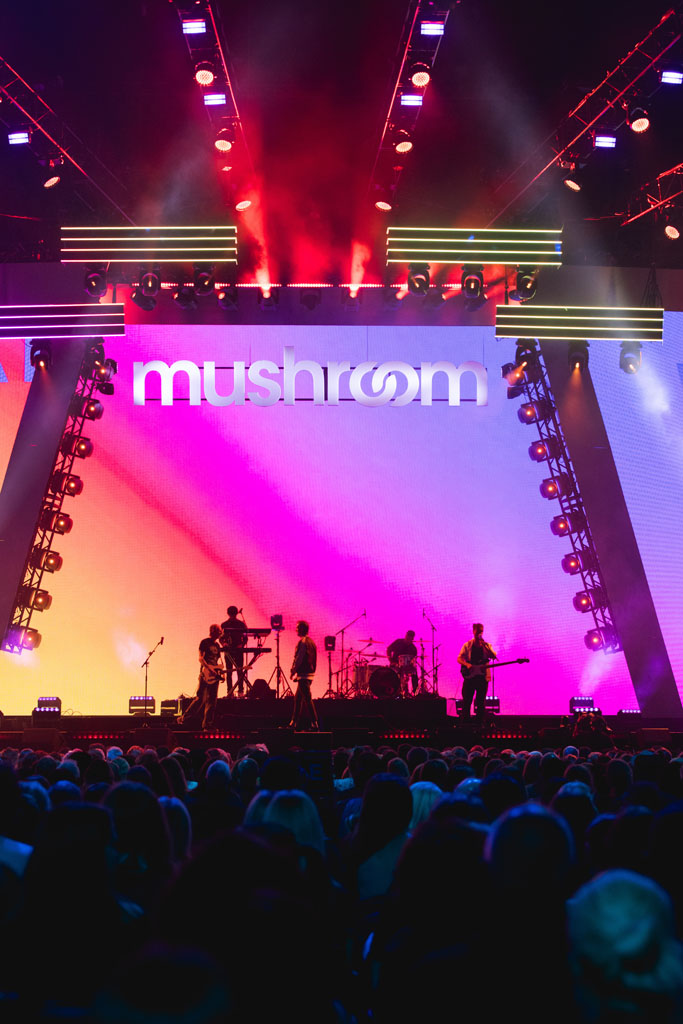
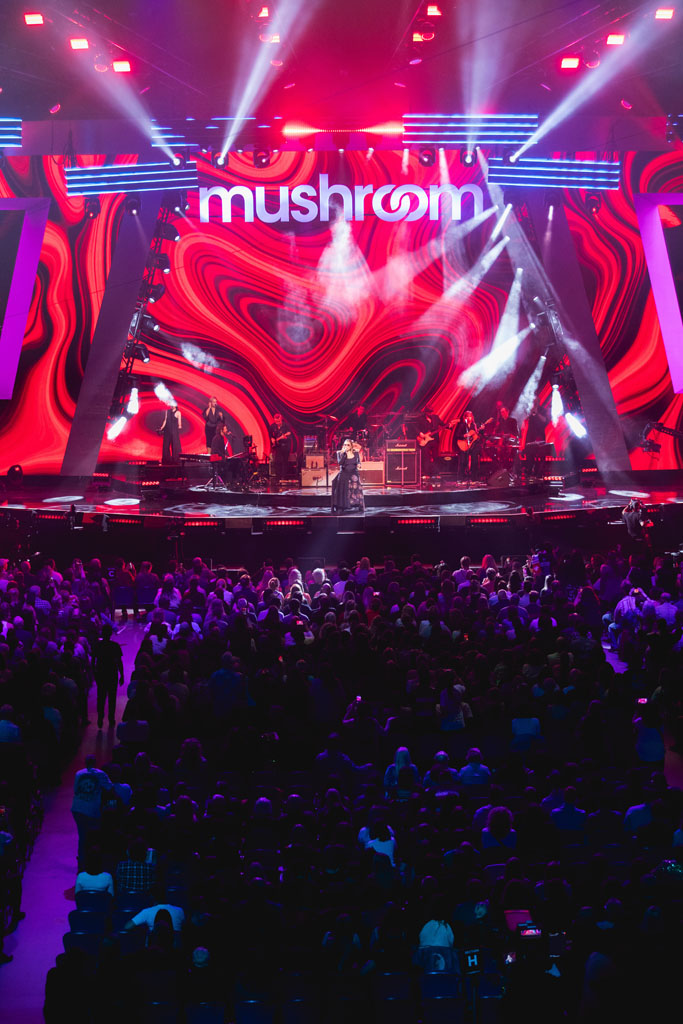
The venue itself has been pushed to the limit by Mushroom 50. “The LED screens alone are 21 tonnes,” says Production Manager Simon Johnson. “We’re about 5 tonne off the front grid weight limit. The screens are about a foot either side off the wall. It’s a beast! We designed the show for this venue, and it just fits in.”
With so many moving parts, clear communication and long-standing working relationships were essential to Mushroom 50’s success. “Because of broadcast partner Creative Technology’s relationship with Tennis Australia, and Mushroom and Frontiers’ relationship with Melbourne Park, we work as one team,” states Simon. “For us, Rod Laver is like no other venue in Australia. We can come here and push things to the limit because we’ve got the backing of the staff. The challenge is this gig’s sheer scale and the tight schedule to get it in. We started marking up at 5 am on Tuesday and had everything in by Wednesday evening.”
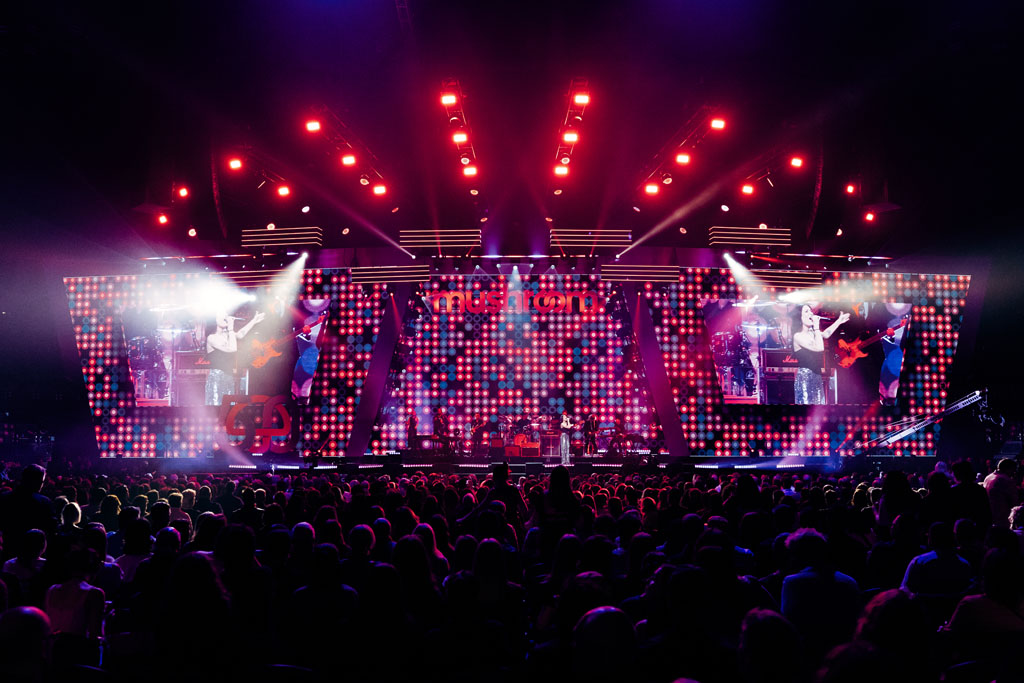
It was a bump-in planned with military precision. “There are 140 rigging points,” illustrates Simon. “Capricorn Stages and Rigging did a fantastic job; we had every point in the air in three hours. After that, all the gear had to go up in a certain order.
Audio, then lighting, then video. Melbourne Park are using a rolling stage at the moment, so we had that in the northern end of the arena while we hung the show in the south, which gave Clifton Productions time to build the revolve on it. Another big challenge was getting set pieces like the screen surrounds in. It’s a very tightly rigged show, and there’s a lot of motors 750mm apart. We had to make sure everything went up in the right order, and we have to make sure it’ll all come out in the right order.”
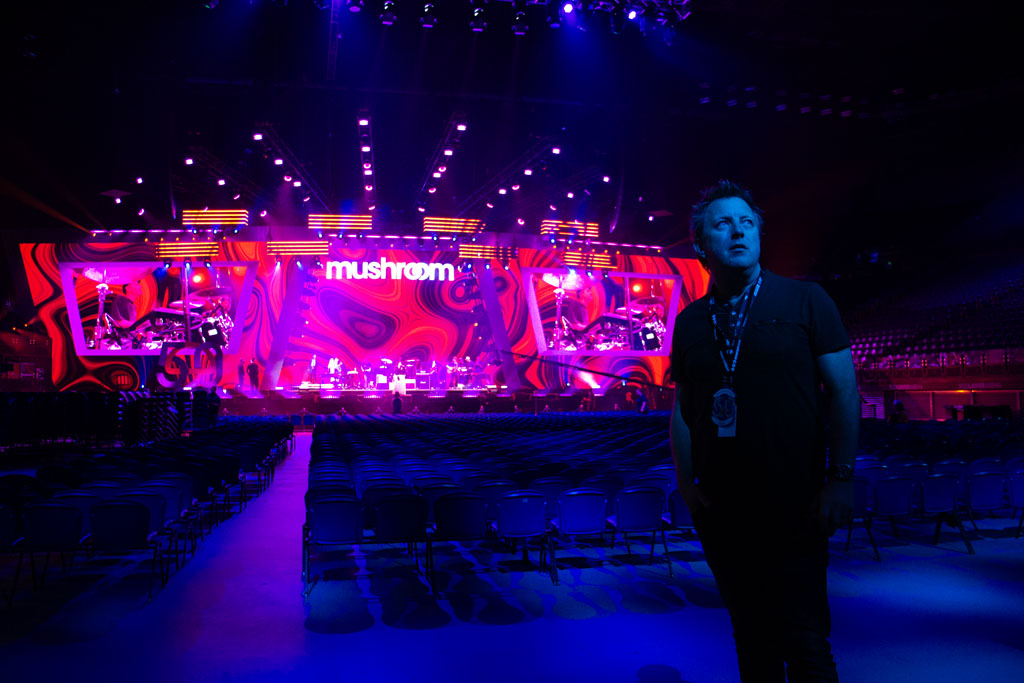
An epic like Mushroom 50 has an epic backstory. “This show has been a concept for 25 years,” says Head of Production Travis Hogan. “It’s genesis dates back to when we did Mushroom 25, and it’s something Michael Gudinski was planning for a long time before he passed. We’ve been working on it solidly for the last nine months. I think one of the hardest decisions we had to make is which artists we have and who we don’t, because you can only fit so much in, and we have a live audience that is here for the best part of five hours.”

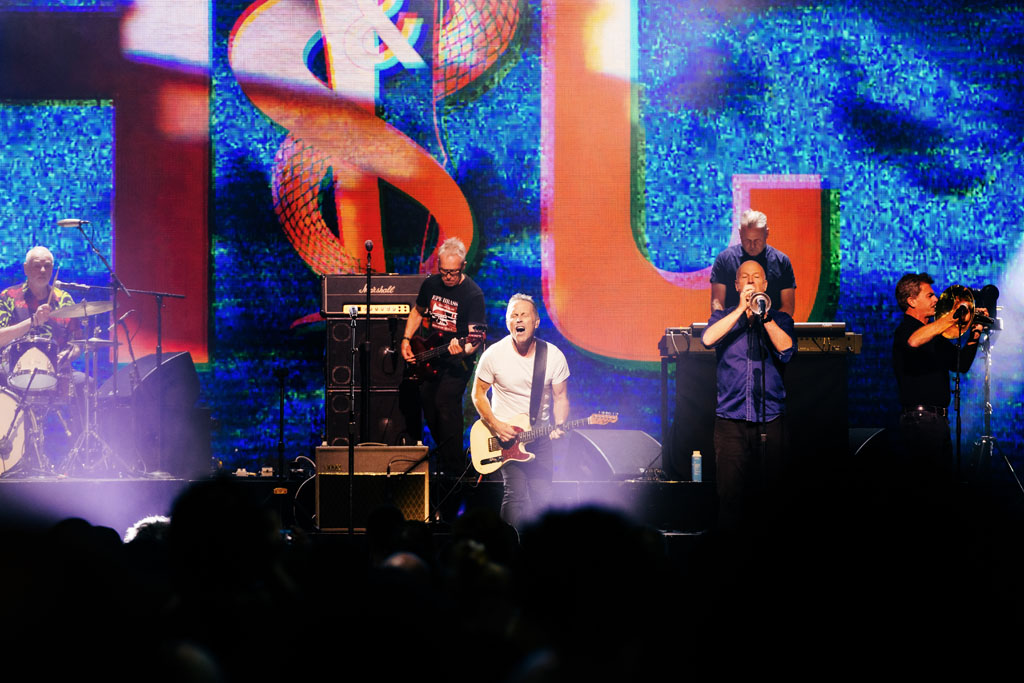
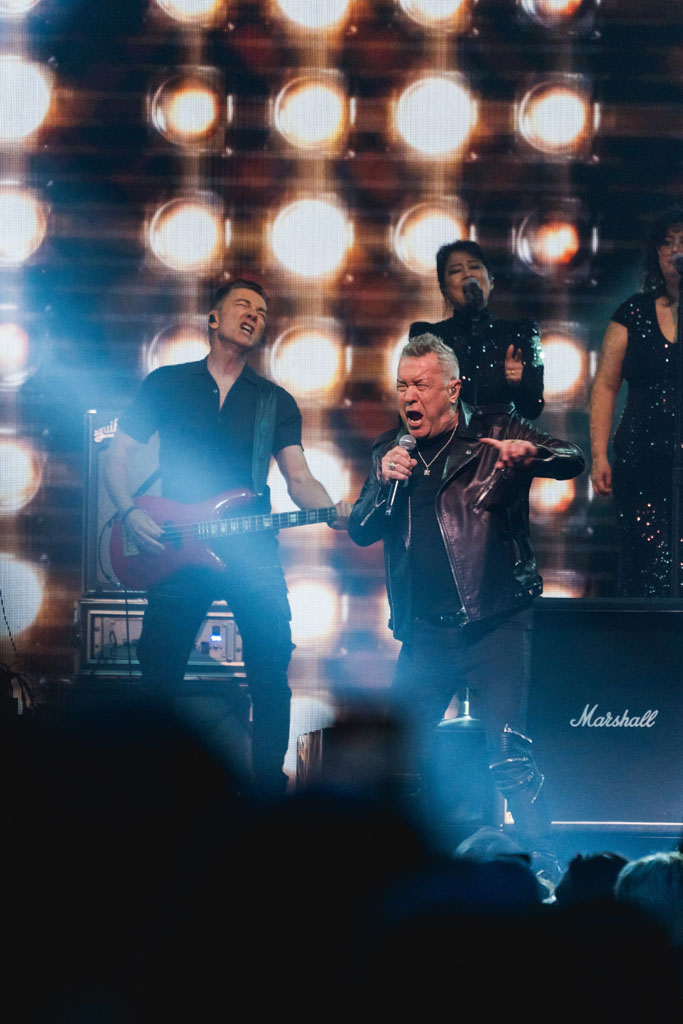
Mushroom 50 won the ratings on the live broadcast, and set the standard for live concert production. “All of the design was fully produced in house by Mushroom,” concludes Travis. “All of the production and stage management is Mushroom staff, supplemented by experts like Hugh and Oysters. There are physical and logistical challenges, and the live broadcast to contend with, but we’re all one big family and that’s what this thing is about.”
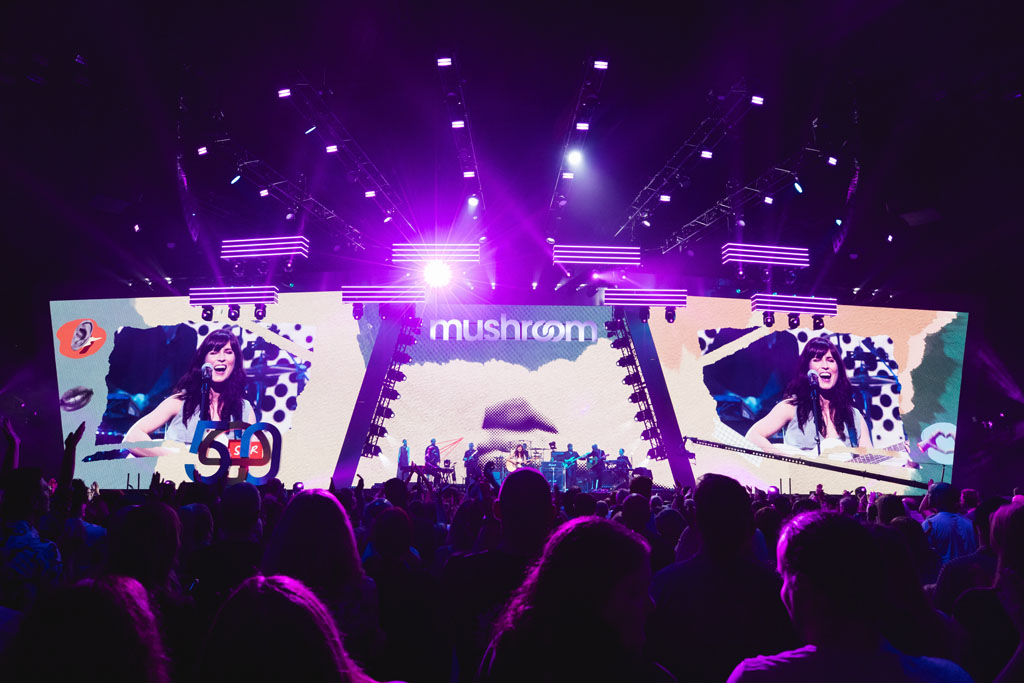
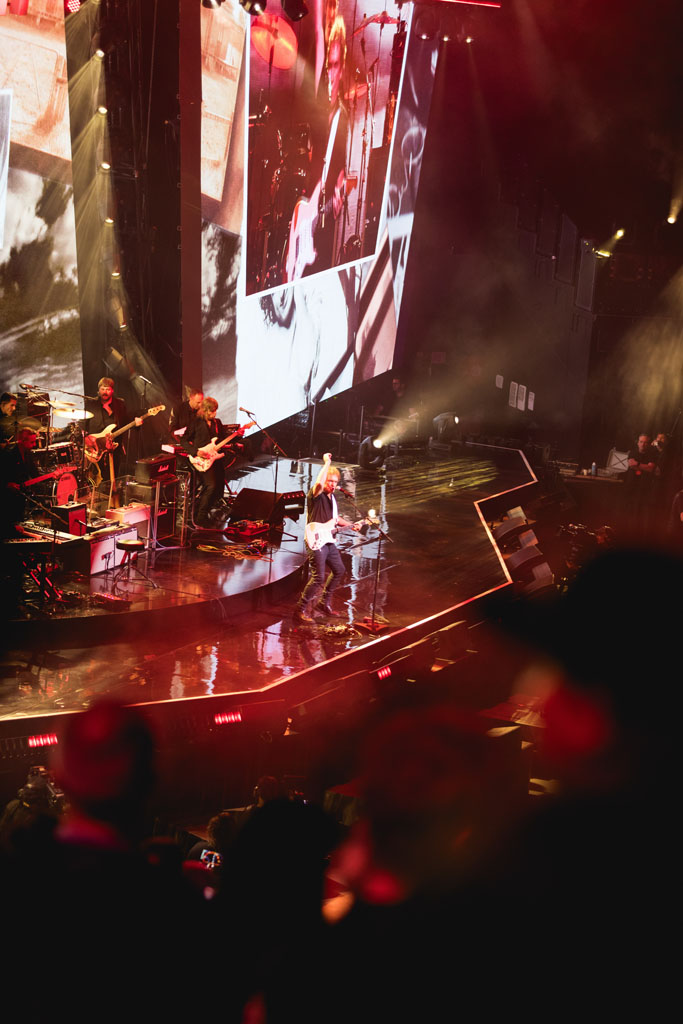
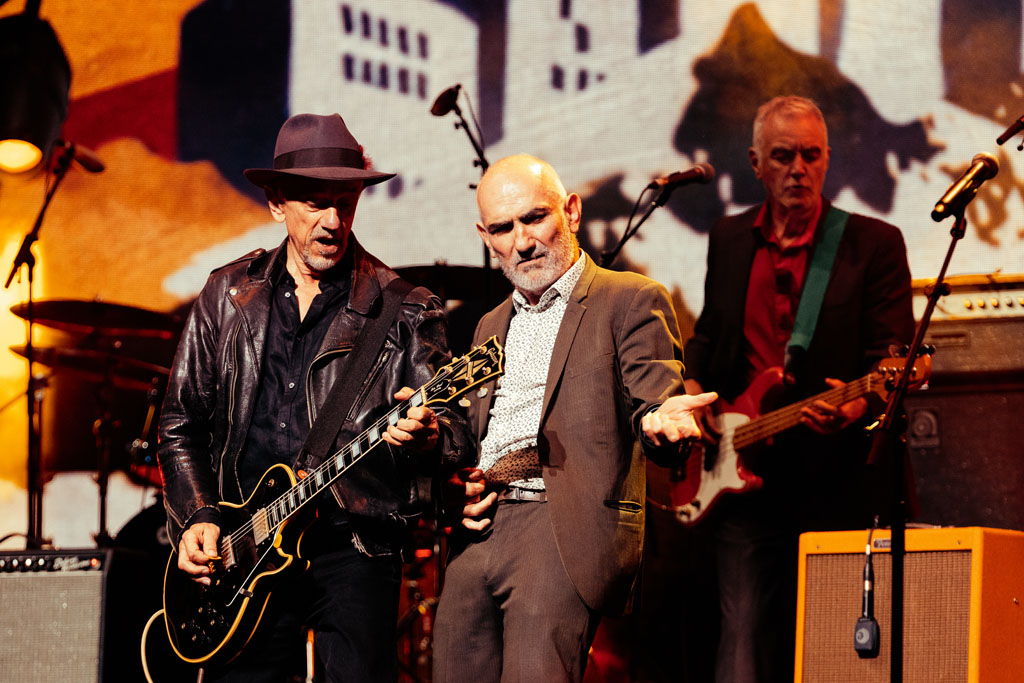
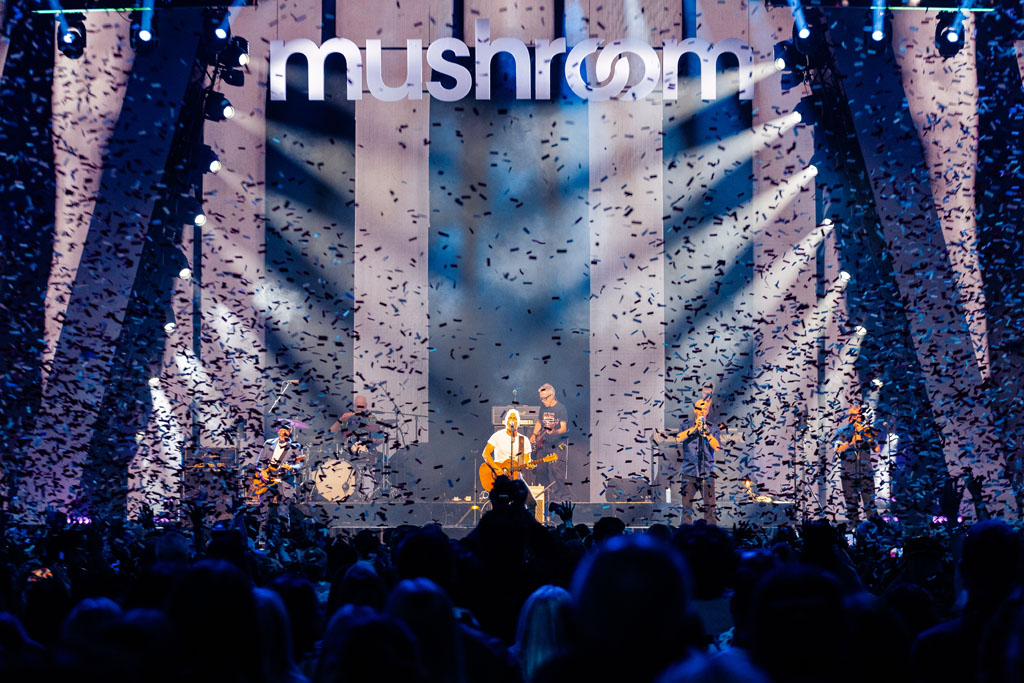
Audio
- DiGiCo SD12 for feature acts FoH, SD5 feature acts monitors
- DiGiCo SD10 house band FoH, SD12 house band monitors
- 4 x 56 channel DiGiCo SD-Racks, 2 x DiGiCo Nano-Racks (not including the broadcast system)
- DiGiCo SD11, acoustic stage, high level and speech returns from broadcast
- Small format Soundcraft digital console used as audio comms mixer
FoH PA
- 52 x d&b audiotechnik KSL8 line array elements
- 12 x d&b audiotechnik KSL12 line array elements
- 12 x d&b audiotechnik SL-SUB subwoofers, flown
- 8 x d&b audiotechnik SL-SUB, floor stacked 8 x d&b audiotechnik Y10P in-fill
Audio Crew
- Audio Director, Mushroom, Mix engineer feature acts – James ‘Oysters’ Kilpatrick
- Mix engineer, house band
- and guest artists – Jimmy Foster
- Monitor engineer for house band and guest artists – David Darlington
- Spectrum Management – Peter Twartz and Anthony Murdoch for PRM
- Broadcast engineer, house band – Ernie Rose, with The Two Nicks on assist
- Broadcast engineer, feature acts – Doug Brady with Brian ‘Scoob’ McMahon assist
- Downstream OB audio engineer/director – Kelvin Mustica
JPJ Audio
- JPJ audio Crew Chief – Sebastian ‘Bass’ Gauci
- System engineer, mix engineer for acoustic stage and high level returns – Josh ‘The Colonel’ DeJong
- System engineer, acoustic stage patch – Tim Jones
- Monitor engineer for feature acts, playback, timecode, and edits – Ryan Fallis, SD5
- RF Tech – Tim Seconi
- RF Tech assist – Stacy ‘Stanley’ Hanley
- Stage patch – Lewis ‘Daddy’ Webbe, Haley Thor
Lighting Crew
- Production Design – Travis Hogan, Simon Johnson
- Lighting Director – Hugh Taranto
- Lighting Console programmer/operator – Chad Spencer
- Followspot Ops – Ben Ralph, Zane Simmell, Jude Doomernik, Mark Kupenga
- PRG Account Manager – Fergal Sullivan
- Lead Lighting System Technicians – Al Blaney, Matt Drinkwater
- Lighting Technicians – Ellie Garnett, Andrew Vaughan
- Advance prep and system design – Gus Wimmer
Lighting Gear
- 60 x GLP X4
- 8 x GLP X4 XL
- 20 x Martin MAC Quantum wash 20 x GLP JDC1
- 27 x GLP X4 Bar 20
- 12 x Martin MAC Viper Performance 45 x Ayrton Perseo
- 28 x Claypaky Mythos 2 40 x PRG Best Boy HP
- 4 x PRG Bad Boy GroundControl 24 x Martin Rush Pars
- 24 x Chauvet Professional Colorado PXL Curve 12
- 16 x ACME Gemini 8 x ArenaCob 4FC
- 3 x MA Lighting grandma2 full size 1 x MA Lighting grandma2 light
- 6 x MA Lighting MA NPU
Video
- Creative Technology, an NEP company 915 x ROE Visual MC5 LED Panels
- Roe Visual EVISION Z6 4K processing
Video Crew
- Peter Gibbs – IMAG/House Director
- Daniel Aulich – Senior Project Manager
- Hamish Phillips – Broadcast Engineer
- Harley McLeod – Broadcast Technician
- Matthew Cattolico – LED Crew Chief
- Dean Pentz – Senior LED Technician
- Taylor Davison – LED Technician
- Sean Killa – disguise/D3 Operator
- Scott Thorneycroft – Broadcast Camera Operator
- Nicholas Carter – Broadcast Camera Operator
Staging and Rigging
- Capricorn Stages and Rigging
- Clifton Productions
Backline
- Deluxe Backline
Mushroom Group
- Production Director – Travis Hogan
- Production Manager – Simon Johnson
- Stage & Backline Manager – Hayden Vassallo
- Assistant Stage Manager – Luke Stabb
- Floor Manager – Brett Millikan
- Production Coordinator – Jeff Chalmers
Subscribe
Published monthly since 1991, our famous AV industry magazine is free for download or pay for print. Subscribers also receive CX News, our free weekly email with the latest industry news and jobs.

